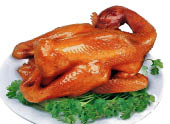Dezhou Braised Chicken
This dish is named after its place of origin, Dezhou in Shandong Province. According to Dezhou City Annals and Dezhou History, the Han family first began to braise boneless chicken with several spices in 1616, and the recipe was passed down from one generation to the next. When Qing Emperor Qianlong (1711 - 1799) traveled to Dezhou, he ordered the Han family to make braised chicken and praised it as “a wonder of all cuisines.” Dezhou Braised Chicken thereafter became a royal tribute.
In 1911, Han Shigong improved the traditional recipe, modifying the frying and stewing procedures and adding more ingredients. Cooked his way, the chicken was more succulent and savory.
In the early 1950s, over 20 descendants of the Han family established a cooperative to produce the braised chicken. Later they set up a shop at the local railway station to sell the specialty to travelers. The dish was quickly popularized: Travelers would spread the word of the tasty chicken and soon it achieved nationwide fame.
In 1956, the descendants joined the state-owned Dezhou branch of the China Food Company. They collaborated to make the dish even more appetizing. In 2006 the skills required to make Dezhou Braised Chicken were listed as part of the intangible cultural heritage of Shandong Province.

Method:
Rub caramelized sugar evenly over the chicken, deep-fry in oil until the skin turns golden. Place a grill at the base of a pot to prevent the chicken from sticking to the bottom and burning; put the prepared chickens into the pot one by one, add a spiced broth and make sure the chickens are fully submerged. Bring to the boil, then reduce the heat and simmer for six to eight hours for young chickens, and eight to ten hours for older ones. The broth is a traditional recipe consisting of 16 ingredients including Sichuan pepper, star anise, Chinese cinnamon, amomum tsaoko (a ginger-like plant), dried tangerine, soy sauce, sugar and salt.
The dish is golden in appearance, tender and savory.

